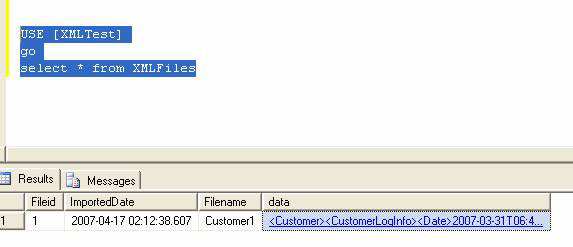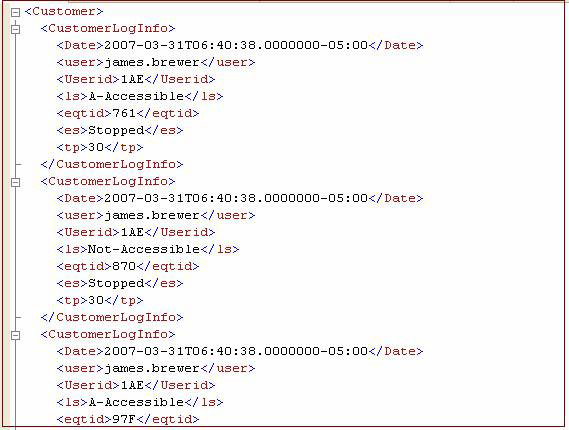Query XML data from a table with XML data type
The purpose of this article is to guide Microsoft SQL Server database administrators in:
• Create XML schema (XML Shema).
• Create a table with XML data type.
• Import XML file into table with XML data type.
• Query XML file.
• Query the XML file and output the result, similar to the output from Transact SQL Statement commands.
Step 1
First, create a C file: XMLCustomer1.XML as shown below. This XML file contains data related to a customer.
2007-03-31T06: 40: 38.0000000-05: 00
james.brewer
1AE
A-Accessible
761
Stopped
30
2007-03-31T06: 40: 38.0000000-05: 00
james.brewer
1AE
Not-Accessible
870
Stopped
30
2007-03-31T06: 40: 38.0000000-05: 00
james.brewer
1AE
A-Accessible
97F
Started
30
Step 2
Create a database (database) and a set of XML Schema as below:
USE [master] GO / ****** Object: Database [XMLTest] Script Date: 04/17/2007 01:49:43 ****** / IF EXISTS (SELECT name FROM sys.databases WHERE name = N'XMLTest ') DROP DATABASE [XMLTest] go to create database XMLTest go to use XMLTest Create XML Schema Collection XMLTrack as N' 'go
Note : updating the Schema collection is based on your own data in the XML file.
Step 3
Create a table with XML data type:
USE [XMLTest]
GO
/ ****** Object: Table [dbo]. [XMLFiles] Script Date: 04/17/2007 02:07:52 ****** /
IF EXISTS (SELECT * FROM sys.objects WHERE object_id = OBJECT_ID (N '[dbo]. [XMLFiles]') AND type in (N'U '))
DROP TABLE [dbo]. [XMLFiles]
create table XMLFiles (Fileid int identity (1,1),
ImportedDate datetime constraint xmldatestamp default getdate (),
Filename varchar (500),
data xml (XMLTrack))
Step 4
Enter the XML file you just created (C: XMLCustomer1.XML), using the openrowset function as shown below:
USE [XMLTest]
go
INSERT INTO XMLFiles (Filename, DATA)
SELECT 'Customer1' a, *
FROM OPENROWSET (BULK 'C: XMLCustomer1.xml', SINGLE_CLOB)
as mytable
go
Note : The SINGLE_BLOB keyword will import the entire XML file for a column with an XML data type.
Step 5
Query the XMLFiles table, using the SQL operations shown below:
USE [XMLTest] go select * from XMLFiles where FileId = 1 go
This command will produce the following results:

Figure 1.0
When you click on the data, it also displays XML data (Figure 1.1).
2007-03-3106: 40: 38.0000-05: 00 james.brewer 1AE A-Accessible 761 Stopped 30 2007-03-31T06: 40: 38.0000000-05: 00 james.brewer 1AE Not-Accessible 870 Stopped 30 2007-03- 31T06: 40: 3800000-05: 00 james.brewer 1AE A-Accessible 97F Started 30

Figure 1.1
Step 6
Now, query the XML data from the table to produce an SQL transaction as the result set. Execute XQuery program as below:
SELECT
ref.value ('Date', 'nvarchar (364)') as [Date],
ref.value ('user', 'nvarchar (364)') as [User],
ref.value ('Userid', 'nvarchar (364)') as [Userid],
ref.value ('ls', 'nvarchar (364)') as [ls],
ref.value ('eqtid', 'nvarchar (364)') as [eqtid],
ref.value ('es', 'nvarchar (364)') as [es],
ref.value ('tp', 'nvarchar (364)') as [tp]
FROM XMLFiles CROSS APPLY Data.nodes ('// Customer / CustomerLogInfo') R (ref)
where Fileid = 1
The program will produce results as shown in Figure 1.2:
Date, User, Userid, ls, eqtid, es, tp 2007-03-3106: 40: 38.0000000-05: 00, james.brewer, 1AE, A-Accessible, 761, Stopped, 30 2007-03-31T06: 40: 38.0000000-05: 00, james.brewer, 1AE, Not-Accessible, 870, Stopped, 30 2007-03-31T06: 40: 38.0000000-05: 00, james.brewer, 1AE, A-Accessible, 97F, Started, 30

Figure 1.2
Step 7
Now repeat step 4 and re-enter the data.
USE [XMLTest] go INSERT INTO XMLFiles (Filename, DATA) SELECT 'Customer1' a, * FROM OPENROWSET (BULK 'C: XMLCustomer1.xml', SINGLE_CLOB) as mytable go
Step 8
Query the table as shown below:
USE [XMLTest] go select * from XMLFiles go
The result is:

Figure 1.3
Step 9
To display all data from both rows, we can write the query as shown below:
SELECT
ref.value ('Date', 'nvarchar (364)') as [Date],
ref.value ('user', 'nvarchar (364)') as [User],
ref.value ('Userid', 'nvarchar (364)') as [Userid],
ref.value ('ls', 'nvarchar (364)') as [ls],
ref.value ('eqtid', 'nvarchar (364)') as [eqtid],
ref.value ('es', 'nvarchar (364)') as [es],
ref.value ('tp', 'nvarchar (364)') as [tp]
FROM XMLFiles CROSS APPLY Data.nodes ('// Customer / CustomerLogInfo') R (ref)
where Fileid = 1
union all
SELECT
ref.value ('Date', 'nvarchar (364)') as [Date],
ref.value ('user', 'nvarchar (364)') as [User],
ref.value ('Userid', 'nvarchar (364)') as [Userid],
ref.value ('ls', 'nvarchar (364)') as [ls],
ref.value ('eqtid', 'nvarchar (364)') as [eqtid],
ref.value ('es', 'nvarchar (364)') as [es],
ref.value ('tp', 'nvarchar (364)') as [tp]
FROM XMLFiles CROSS APPLY Data.nodes ('// Customer / CustomerLogInfo') R (ref)
where Fileid = 2
The results are in the form of Figure 1.4.
Date, User, Userid, ls, eqtid, es, tp 2007-03-3106: 40: 38.0000000-05: 00, james.brewer, 1AE, A-Accessible, 761, Stopped, 30 2007-03-31T06: 40: 38.0000000-05: 00, james.brewer, 1AE, Not-Accessible, 870, Stopped, 30 2007-03-31T06: 40: 38.0000000-05: 00, james.brewer, 1AE, A-Accessible, 97F, Started, 30 2007-03-3106: 40: 38.0000000-05: 00, james.brewer, 1AE, A-Accessible, 761, Stopped, 30 2007-03-31T06: 40: 38.0000000-05: 00, james.brewer, 1AE, Not -Accessible, 870, Stopped, 30 2007-03-31T06: 40: 38.0000000-05: 00, james.brewer, 1AE, A-Accessible, 97F, Started, 30
Note: If you are planning to display all data from each row with an XML data type, you can create a stored procedure with a temporary table or pointer .

Figure 1.4
Conclude
This article illustrates how to create an XML Schema, create a table with an XML data type, import an XML file into a table with an XML data type, query the XML file, and produce the same result as the actual result set. shown by SQL Transact commands.
 Improvements in ASM
Improvements in ASM The ten biggest errors developers have with databases
The ten biggest errors developers have with databases Use and manage Database Mail
Use and manage Database Mail Processing data in Java in Oracle
Processing data in Java in Oracle Create .Net applications on Linux and Mac OS X
Create .Net applications on Linux and Mac OS X CASE function in SQL Server (part 1)
CASE function in SQL Server (part 1)